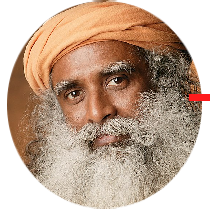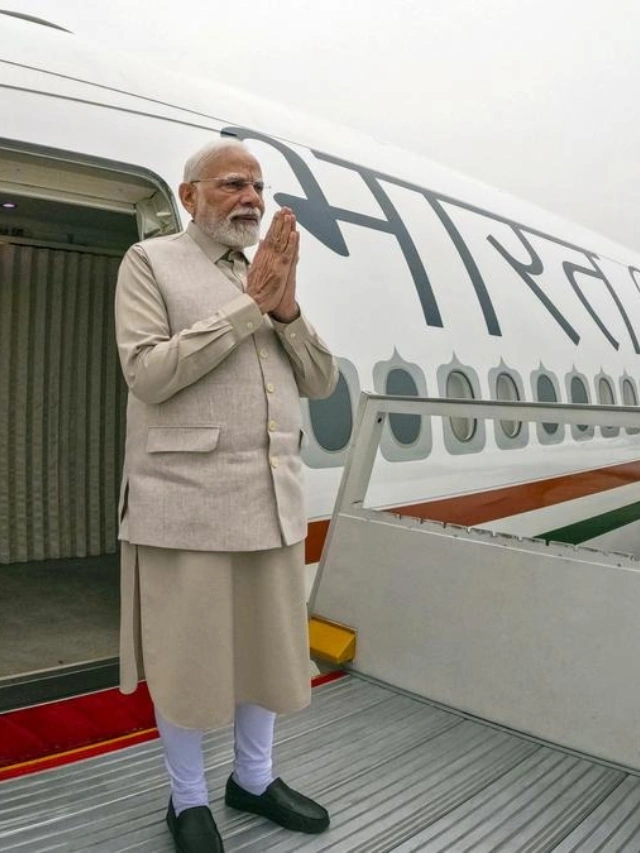Sadhguru Jaggi Vasudev
Sadhguru Jaggi Vasudev went from being a businessman to becoming one of India’s most influential spiritual leaders after his birth on September 3, 1957. Millions worldwide know him simply as Sadhguru, and his 31-year-old Isha Foundation runs an ashram and yoga center that focuses on educational and spiritual activities.
Several spiritual awakenings led Sadhguru to leave his business ventures and teach yoga. His first class took place in Mysore in 1983. He has since created a global spiritual movement and written powerful books like “Inner Engineering: A Yogi’s Guide to Joy” and “Karma: A Yogi’s Guide to Crafting Your Destiny”.
CEO’s | Actors | Politicians | Sports Stars
The Indian government recognized his contributions to spirituality and humanitarian services with the Padma Vibhushan, the country’s second-highest civilian award in 2017. That same year marked another milestone when he consecrated the Adiyogi Shiva statue in Coimbatore, which stands as the world’s largest bust.

Early Life of Jagadish Vasudev
Family background and childhood
Birth and Family: Jagadish “Jaggi” Vasudev, known worldwide as Sadhguru, was born on September 3, 1957, in Mysore, Karnataka, India. He grew up in a Telugu family as the youngest of five children, with one brother and two sisters. His birth order shaped his development. He often mentioned that his mother had become a “practiced mother” by the time he arrived.
Parental Influence: His father, B.V. Vasudev, served as an ophthalmologist at the Mysuru Railway Hospital, giving the family a stable and comfortable life. His mother, Susheela Vasudev, dedicated her life to homemaking and family care. She never earned “a single Rupee,” yet she held the highest respect in their home. Sadhguru often said, “She was the most respected person in the house, for sure. Nobody could imagine that household without her”.
Maternal Creativity: His mother’s creative spirit left a lasting impression on young Jagadish. She showed her artistic flair through everyday acts of care. During their family trips, she would decorate plain white pillowcases with intricate embroidery – pink flowers or bright green parrots – all done within minutes. “I would fall asleep looking at that green parrot,” Sadhguru remembers. “That green parrot: what it’s done to me, nobody can understand. It made me fly”. This memory gives us a glimpse into his imaginative mind that would emerge later.
Sadhguru’s real name and roots
Cultural Identity: Jagadish Vasudev’s Telugu family raised him in Karnataka, which created a unique blend of both traditions. He says he was “born and brought up as a Kannadika” despite his Telugu heritage. This mix of cultures helped him connect with different audiences later in life.
Family Heritage: Some sources suggest his mother’s family line goes back to the legendary Krishnadeva Raya. Young Jagadish first met Mallidihalli Sri Raghvendra at his mother’s ancestral home, where he learned his first yogic practices. This meeting shaped his spiritual journey significantly.
Educational Foundation: After his early schooling in Mysore, Jagadish studied English literature at the University of Mysore. His background in literature, rather than business or engineering, helped him explain complex spiritual ideas through simple language and powerful metaphors.
Influence of nature and freedom in youth
Mountain Connection: Jagadish shared a special bond with mountains from his earliest days. “Right from my infancy, I had an image of a mountain peak in my mind. Eyes open or eyes closed, it was always there”. He thought everyone saw similar visions until he turned sixteen. Conversations with friends made him realize his experience was unique. This discovery sparked his quest to find the specific peak he kept seeing.
Wilderness Explorer: His love for nature led him to trek extensively through the Western Ghats of Karnataka and Kerala. He rode his motorcycle from Karwar to Kanyakumari eleven times to check every possible peak. At nineteen, he ventured to the Himalayas but knew immediately these weren’t his vision’s mountains. He later found that specific peak in southern India – where the Isha Yoga Center stands today.
Freedom on Two Wheels: His motorcycle became his companion in exploration. “I literally lived on a motorcycle for almost seven years,” he shares, covering between 55,000 and 60,000 kilometers yearly. His Jawa motorcycle became part of him as he traveled across India without any destination. “I just loved to see the terrain, every bit of the landscape”. These aimless journeys changed him deeply: “These travels were probably the richest part of my life because I traveled without purpose”.
Distinctive Character: Jagadish stood out from other children early on. “Since childhood, he was very different from other children. If there is a definition for wild he will fit into that”. He spent his time “roaming in jungle, observing wildlife, catching snakes, traveling, hiking and bike riding”. This free-spirited approach to exploration laid the foundation for his spiritual teachings.
Nature as Teacher: His early experiences with nature molded his views on human growth. Modern children miss out on vital connections with “plant life, animal life, insect life, reptile life, every other kind of life”. Living alone in jungles for weeks taught him that “every creature – ants, insects, animals, birds – has a complete life of its own”. This understanding challenges what he calls “the most disastrous idea” given to humanity: that other life forms exist only to serve human needs.
Education and the Making of a Thinker
Studying English literature at University of Mysore
Academic Foundation: Jagadish Vasudev went to Demonstration School in Mysore and Mahajana Pre-University College before joining the University of Mysore to study English literature. This choice would help him express complex spiritual ideas in simple language later in life.
Academic Excellence: Jagadish showed remarkable intellectual skills at university. He ranked second in his program and stood out as one of the brightest students in his batch. He achieved this despite what some sources call “a spotty attendance record and an irreverent attitude to tuition”.
Beyond Academics: Jagadish stayed connected with nature throughout his college years. His passion for motorcycles grew during this time, and he rode extensively across India. This mix of formal education and real-life learning became a key part of his teaching style later.
Why he chose not to pursue post-graduation
Parental Expectations: Jagadish’s parents wanted him to continue studying after his undergraduate success. Like many Indian families then, they saw higher education as the path to a secure future.
Independent Vision: Jagadish knew what he wanted and said no to further studies. This showed how he trusted his gut feeling over social norms—a trait that would shape his spiritual path.
Business Orientation: He chose to start a business career instead of staying in academics. This choice showed his practical side and entrepreneurial spirit. He started several businesses after graduation, including a poultry farm and construction company. His choice proved he was independent and practical.
Broader Viewpoint: He knew that school alone couldn’t answer his questions about life’s meaning. Though he valued his literature degree, Jagadish realized he needed to learn from the world outside classrooms.
Early signs of a questioning mind
Childhood Curiosity: Jagadish asked unusual questions from an early age. He later said that “ever since he was a little boy, he used to question everything that exists”. This made him different in a culture where children rarely questioned their elders.
Persistent Seeker: Unlike other kids who stopped asking when discouraged, Jagadish kept looking for answers. He would “start seeking the answer until they reached to the point where they could come to the conclusion”. This drive to understand led him toward spiritual exploration.
Experiential Learning: Jagadish didn’t just ask questions—he explored. He loved nature and spent time hiking in forests alone. He even kept snakes as pets. These experiences helped develop his observation skills and bond with nature.
Intellectual Independence: Jagadish thought differently throughout his school years, which sometimes clashed with traditional teaching methods. His “irreverent attitude to tuition” showed his need for more than just memorizing facts.
Foundation for Future Teachings: The questioning mind he developed early on became the foundation of Sadhguru’s spiritual approach. His literature background and natural curiosity created the perfect mix. Now he connects with educated audiences worldwide and tackles complex philosophical questions with clarity.
From Businessman to Seeker
Starting a poultry farm and construction business
Entrepreneurial Beginnings: Jagadish Vasudev chose an unexpected path after completing his studies at the University of Mysore. He decided to start a poultry farm in Mysore instead of pursuing postgraduate studies as his parents wished. This bold move showed his independent spirit as he carved his own path.
Strategic Business Choice: His reason behind choosing a poultry farm came from a deeper place. The business needed minimal daily attention, which gave him plenty of free time. He later explained that this choice stemmed from “the serenity it yielded in the hours he was not working”. Jagadish wanted more than just money – he sought personal freedom.
Business Expansion: The poultry business became more profitable, but his family continued to resist. They kept criticizing his choice to work in the poultry industry. This opposition led him to enter the construction industry with a company called Buildaids. He launched this venture with his civil engineer friend, using experience he gained from building his poultry facilities.
Self-Taught Engineer: Jagadish succeeded in construction without formal engineering training. He applied practical knowledge from building his poultry farm. This hands-on approach and adaptability became defining traits throughout his life.
Balancing entrepreneurship with poetry and solitude
Creative Expression: Jagadish managed to keep his life as a poet alive while running his businesses. The poultry business’s minimal demands gave him time to write poetry. This creative side revealed his deeper, contemplative nature alongside his business drive.
Motorcycle Wanderer: His love for travel blossomed during college days. He found passion in riding motorbikes, exploring without specific destinations. These “purposeless wanderings” became fertile ground that shaped his growing consciousness.
Charitable Mindset: Jagadish’s social consciousness emerged early. He rented out his poultry farm and gave the income to people in need. He also taught yoga students and used this money for charitable causes.
Dual Nature: This phase revealed Jagadish Vasudev’s many sides – a successful businessman, creative thinker, motorcycle enthusiast, and emerging spiritual seeker. He knew how to balance these contrasting aspects, which later shaped his teachings about mixing spirituality with daily life.
Turning point: the spiritual experience on Chamundi Hill
Unexpected Awakening: Jagadish’s life changed dramatically at age 25. He rode his motorcycle up Chamundi Hill in Mysore city on September 23, 1982. Something extraordinary happened as he sat on his usual rock with his eyes open – an experience that would change his life forever.
Boundary Dissolution: He described it: “After a few minutes, I didn’t know where I was. Till that moment, like most people, I always thought this is me and that is someone else. But for the first time I did not know what is me and what is not me. What was me spread through all over the place”. This moment marked his spiritual awakening.
Time Distortion: Minutes felt different that day. “I thought this madness lasted for 5 to 10 minutes but when I came back to my normal way of being, four-and-a-half hours had passed”. He sat there from 3:00 PM until 7:30 PM, fully aware yet in a different state of consciousness.
Physical Manifestation: His body responded strongly to the experience. “For the first time in my adult life, tears were flowing to a point where my shirt was completely wet,” he said. An “indescribable ecstasy” filled his entire being during this time.
Recurring Experiences: Similar experiences followed. He lost track of time for seven hours while sitting at the dinner table with family. Another time, this state lasted 13 straight days.
Complete Transformation: These experiences changed him completely within six weeks. His voice changed, and even his eyes’ shape transformed. Photos from this time clearly show these physical changes.
Radical Decision: Jagadish closed his businesses after these spiritual experiences. He trusted his business matters to a friend and focused entirely on spiritual pursuits. By 1983, he started teaching yoga in Mysore without charging fees, living off money from his previous businesses. The businessman Jagadish Vasudev transformed into Sadhguru, the spiritual teacher.
The Birth of Sadhguru
What happened after the spiritual awakening
Transformative Experience: The deep spiritual experience at Chamundi Hill was just the start of Jagadish Vasudev’s transformation. He went through dramatic physical changes in just six weeks after that September day in 1982. His voice changed and even his eyes took on a different shape. Photos from this time clearly show these remarkable physical signs of his inner change.
Recurring Experiences: The first awakening wasn’t a one-time event. Jagadish soon started experiencing similar states during everyday activities. Once, while having dinner with his family, he lost track of time—what felt like two minutes to him turned out to be seven hours. Even more amazing, this heightened awareness lasted non-stop for 13 days.
Seeking Understanding: These experiences left Jagadish both puzzled and intrigued. He handed over his businesses to a trusted friend and started a journey across India to understand these mystical states. His travels and self-reflection lasted about a year as he tried to learn about the nature of his consciousness.
Why he left everything behind
Inner Calling: Giving up his successful businesses wasn’t easy. Jagadish felt pulled by a deep inner certainty that his life’s purpose had completely changed. He described it saying, “Every cell in my body was just bursting with ecstasy”—a feeling so intense that going back to regular business seemed impossible.
Universal Vision: Jagadish saw something bigger than personal growth in his experiences. He became convinced that “this blissfulness that was simply bursting within me… could happen in every human being”. This insight drove him to share these possibilities with others, whatever sacrifices it took.
Complete Dedication: Unlike others who might try to balance spiritual work with business, Jagadish made a clean cut. He stepped away from all his business activities shortly after his experiences. His total commitment showed he knew that half measures wouldn’t work—he had seen something that needed his full attention.
First yoga class and the beginning of teaching
Inaugural Teaching: Jagadish taught his first yoga class in Mysore in 1983, about a year after his spiritual awakening. He started small with just seven students, but this marked the beginning of what would grow into a worldwide spiritual movement. He called his early teaching program “Sahaja Sthiti Yoga”.
Mobile Teacher: After his first class, Jagadish rode his motorcycle all over Karnataka and Hyderabad. His love for motorcycle travel made this a natural way to spread his teachings. His classes grew popular fast, and soon he was teaching up to 15,000 people at once.
Financial Approach: Jagadish never charged money for his teachings. He lived off the rent from his poultry farm to stay financially independent while focusing on spiritual work. He collected donations after classes but gave all the money to local charities, showing the selfless attitude that would define his work.
Teaching Philosophy: Jagadish’s way of teaching yoga was different from the start. His classes focused more on inner experience than just physical poses. He wanted to help others find the same transformative awareness he had found—making his teachings both practical and deeply spiritual from day one.
Founding the Isha Foundation
Vision behind Isha Yoga Center
Official Establishment: Jagadish Vasudev founded the Isha Foundation near Coimbatore, Tamil Nadu, India in 1992. The name “Isha” carries a deeper meaning—it represents “the formless divine” according to Sadhguru. His vision went beyond just teaching spirituality and he wanted to “offer the science of inner wellbeing to every human being”.
Core Mission: Sadhguru created the foundation to help “raise every human being to the peak of their potential”. This vision took shape in 1994 with the Isha Yoga Center, which started offering programs called “Isha Yoga”. The system differed from traditional yoga lineages by combining multiple elements—postural yoga with chanting, breathing techniques (prāṇāyāma), and meditation.
Comprehensive Approach: We focused on complete personal growth. The foundation’s activities had a clear purpose—to “create an inclusive culture that is the basis for global harmony and progress”. Sadhguru foresaw spaces where seekers could experience powerful energies while working together as a community.
Volunteer-driven model
Operational Framework: The Isha Foundation runs almost entirely through volunteer efforts. The organization states clearly: “Every single action and activity of the foundation and its worldwide centers is done on a volunteer basis”. This volunteer-driven model reflects both a practical solution and the organization’s core philosophy.
Volunteer Demographics: People from all walks of life volunteer at Isha. Business professionals, lawyers, engineers, artists, IT professionals, and freelancers find their place within the organization. This mix of talents helps the foundation tackle complex projects without needing many paid staff.
Transformational Experience: Volunteering at Isha serves two purposes. Volunteers contribute to various projects and experience personal growth. The foundation describes volunteering as bringing “a deep sense of involvement” that “serves as a powerful tool for inner transformation”. This blend of service and spiritual growth forms the life-blood of Isha’s volunteer model.
Practical Implementation: The volunteer system offers great flexibility. You can contribute based on your schedule—from 5-day commitments to 180-day periods. After completing the Inner Engineering program, volunteers can stay free of cost at the ashram’s dormitory. This open approach welcomes participation from people of all backgrounds.
Growth into a global spiritual movement
International Expansion: Isha Foundation grew beyond Indian borders. The organization brought yoga programs to the United States in 1997, marking its first international step. Three decades of growth led to operations “out of over 200 city centers in India, the US, Europe, Asia and the Middle East”.
Volunteer Base Growth: The volunteer community grew rapidly. The foundation now has “over 2 million volunteers worldwide”, showing how its approach appeals across cultures. This huge network of volunteers helps implement large-scale projects globally.
Diversified Activities: The foundation’s work now reaches far beyond yoga classes. Isha’s activities include inner transformation programs, environmental initiatives, and social outreach efforts. Business programs aim to “introduce a sense of compassion and inclusiveness” to economics, showing Sadhguru’s vision of spirituality touching every part of life.
Financial Evolution: The foundation developed steady income streams. Its US chapter reported revenues of INR 3375.22m in 2022. It also sells yoga mats, personal care items, and accessories. This financial base supports ambitious projects while staying true to the volunteer-driven model that defines Isha’s character.
Environmental and Social Campaigns
Rally for Rivers and Cauvery Calling
Unprecedented Environmental Movement: Sadhguru Jaggi Vasudev leads several ecological initiatives beyond his spiritual teachings. He launched Rally for Rivers in 2017 and drove 9,300 kilometers across 16 states in just 30 days. His campaign included 146 public events and more than 700 media interactions. This effort reshaped India’s ecological movement scene.
Massive Public Support: The campaign got support from an incredible 162 million people in just one month. This made it history’s largest public-endorsed mass awareness campaign. The overwhelming response led to government action, which resulted in a $2.5 billion policy to revitalize rivers.
Cauvery Calling Initiative: Sadhguru launched Cauvery Calling in 2019 after Rally for Rivers’ soaring win. Known as “the world’s largest farmer-driven ecological movement”, this project wants to help 5.2 million farmers plant 2.42 billion trees through tree-based agriculture. The project now serves as a model for tropical river restoration worldwide.
Project GreenHands and Save Soil
Grassroots Ecological Initiative: Isha Foundation’s Project GreenHands (PGH), 19 years old, works to increase green cover and restore soil health. PGH has helped plant more than 17 million saplings with help from over 2 million volunteers.
Record-Breaking Achievement: PGH earned its spot in the Guinness Book of World Records in 2006. 852,587 saplings were planted in just three days by more than 250,000 volunteers. This remarkable achievement earned PGH India’s highest environmental award – the Indira Gandhi Paryavaran Puraskar.
Save Soil Campaign: Sadhguru began another bold project in 2022 – a 100-day motorcycle journey from London to India called ‘Journey to Save Soil’. This campaign raises awareness about soil degradation and promotes organic farming.
Global recognition and UN involvement
International Acknowledgment: Sadhguru’s ecological initiatives have caught global organizations’ attention. These projects show how development can be both economically viable and environmentally sustainable.
United Nations Engagement: The UN, UNEP (United Nations Environment Program), and UNCCD (United Nations Convention to Combat Desertification) have invited Sadhguru to share solutions for ecological challenges. He addressed leaders from 195 countries at the United Nations Convention to Combat Desertification about the Save Soil movement.
Organizational Partnerships: Major international bodies like UNDP and IUCN (International Union for Conservation of Nature) now support Isha Outreach’s work, especially the Cauvery Calling project. These endorsements highlight Sadhguru Jaggi Vasudev’s environmental vision and its potential worldwide impact.
Personal Life and Family
Sadhguru wife and daughter
Marriage Bond: Jagadish Vasudev met Vijaykumari (Vijji), who would become his wife, two years after his spiritual awakening. Their story began at a lunch in Mysore. They exchanged heartfelt letters before getting married in 1984 on Mahashivratri.
Family Beginnings: The couple had their only child, Radhe Jaggi, in 1990. “My wife was very keen on a child,” Sadhguru said, as Vijaykumari believed motherhood was a vital experience in a woman’s life. Before becoming a father, Jagadish had a clear picture of sending a daughter to specific schools—a vision that came true exactly as he had imagined.
Tragic loss of his wife and public scrutiny
Spiritual Departure: Vijaykumari left her physical form on January 23, 1997, at age 33. Sadhguru explained that she attained Mahasamadhi—a yogic practice where accomplished practitioners consciously leave their physical bodies. “She was at the peak of her health,” he said, adding that she “left, without any effort and with a big smile on her face”.
Public Controversy: Questions arose about Vijaykumari’s death. Her father raised concerns by filing a police complaint seven months later. He questioned why the cremation took place before the family arrived. Police found no evidence of foul play after looking into witness statements and forensic evidence.
Sadhguru daughter name and her artistic journey
Artistic Education: Radhe Jaggi, born in 1990, studied at Rishi Valley School in Andhra Pradesh and earned her BA from Chennai University. She became an accomplished Bharatanatyam dancer under the guidance of respected gurus like Sheejith Krishna, Shijith Nambiar, and others.
Professional Achievement: Radhe’s talent in Bharatanatyam took her to stages across the United States, Korea, Malaysia, and London. Tamil Isai Sangam recognized her skill with the title “Natya Kalai Arasi”. She holds a postgraduate diploma in Arts Management from DakshinaChitra and completed Journalism and Business Leadership courses at Harvard Summer School.
Personal Journey: Radhe carved her own path despite her father’s spiritual status. She married classical vocalist Sandeep Narayan on September 3, 2014. Speaking about growing up, she shared: “My father never put pressure on me to follow the conventional path… He only insisted that whatever I did, I did with complete involvement”.
Public Image and Legacy
Books, speeches, and global influence
Literary Impact: Sadhguru Jaggi Vasudev has written more than thirty books that have gained recognition worldwide. His works “Inner Engineering: A Yogi’s Guide to Joy” and “Karma: A Yogi’s Guide to Crafting Your Destiny” became New York Times bestsellers. These books have reached readers globally through translations in multiple languages.
Global Platform: Sadhguru’s voice resonates at prestigious international forums. He has shared his wisdom at the United Nations’ Millennium World Peace Summit, the British House of Lords, Massachusetts Institute of Technology, and the International Institute for Management Development. His presence at the World Economic Forum in 2007, 2017, and 2020 strengthened his global influence.
Digital Influence: Sadhguru’s YouTube channel boasts over 11.4 million subscribers. His content gets more views and thus encourages more ad revenue ranging from INR 151.88K to INR 3324.59K monthly. His message reaches people worldwide through various social media platforms.
Sadhguru Jaggi Vasudev net worth and honors
Financial Standing: Different sources report varying estimates of Sadhguru’s net worth. Several publications mention a figure close to Rs 18 crore. Other estimates range from INR 4219.02 million to INR 150 million. His foundation maintains that as a non-profit organization, they reinvest all revenue into charitable, environmental, and spiritual services.
Government Recognition: Then-President Pranab Mukherjee presented Sadhguru with the Padma Vibhushan, India’s second-highest civilian award, on April 13, 2017. This honor recognized his distinguished service in spirituality. Sadhguru dedicated the award to “over seven million volunteers of Isha worldwide”.
Recent Accolades: The Canada India Foundation named Sadhguru the ‘Global Indian of the Year‘ in 2024. He received a cash prize of CAD 50,000 and immediately dedicated it to the ‘Cauvery Calling’ project. This act shows his steadfast dedication to environmental restoration even as his recognition grows.
FAQ:
What is Sadhguru’s age / date of birth?
Sadhguru (Jaggi Vasudev) was born on 3 September 1957, making him 68 years old (as of 2025).
Does Sadhguru have a daughter?
Yes. He has a daughter named Radhe Jaggi.
Was Sadhguru married?
He was married to Vijaya Kumari (often called Vijji) in 1984. She passed away in 1997.
What is the Isha Foundation?
The Isha Foundation is a nonprofit spiritual organisation founded by Sadhguru in 1992, focused on yoga, meditation, ecological conservation, education, and social upliftment.
What is Sadhguru’s net worth?
His net worth is estimated to be around USD 25 million.
Who is Sadhguru?
Sadhguru is an Indian yogi, mystic, author, and spiritual teacher. He is the founder of Isha Foundation and is known worldwide for his teachings on inner transformation, consciousness, and wellbeing.
What is Sadhguru’s real name?
His real name is Jagdish “Jaggi” Vasudev. “Sadhguru” is his spiritual title and public identity.
What is “Inner Engineering” in relation to Sadhguru?
Inner Engineering is a flagship program offered by Sadhguru and Isha Foundation that teaches tools and processes — including meditation, kriya, and yoga — aimed at inner wellbeing, clarity, and self-transformation.
Who is Sadhguru’s son-in-law?
His daughter Radhe married Sandeep Narayan, a Carnatic vocalist, making him Sadhguru’s son-in-law.
What is Sadhguru’s approach to yoga?
Sadhguru teaches an integrated form of yoga combining asanas, meditation, pranayama, and kriya practices that focus on uniting body, mind, and inner experience — extending beyond physical postures.




